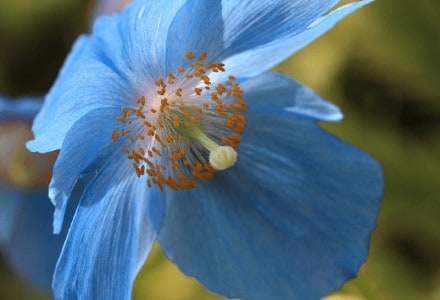
Himalayan Blue Poppy Facts
- Perhaps most notably, the descriptive term of Himalayan Blue Poppy serves as the most frequently used common name for a truly stunning variety of flora. However, some people also know the gorgeous plant by its alternate common name, the Lingholm. Nonetheless, the scientific name of this stunning species remains that of the difficult to pronounce Meconopsis betonicifolia.
- Yet, regardless of the term one uses to refer to it, this remarkable Angiosperm has a fascinating history. That’s because, aside from local inhabitants, it remained unknown until the year 1912. At that time, though, Lt. Colonel Frederick Marshman Bailey made the fortuitous discovery for the rest of the world. Furthermore, this stunning marvel of Nature now forms an extremely popular ornamental plant.
- However, the magnificent Himalayan Blue Poppy remains quite rare in the wild. Regardless of this fact, though, it does not yet appear on the IUCN Red List of Threatened Species. But, despite this surprising omission, many experts consider the species to be in danger of potential extinction. Finally, its greatest dangers appear to consist of the dual threats of habitat loss and climate change.
Related Articles
Rosy Periwinkle Amazon Lily Fairy Lantern
Himalayan Blue Poppy Physical Description
First of all, the truly breathtaking variety of flora known as the Himalayan Blue Poppy doesn’t actually qualify as a poppy at all. The slight confusion holds true due to the fact that the name of the marvelous plant derives from its physical resemblance to one. Nonetheless, this species puts on a show with several amazing poppy-like characteristics.
Firstly, one must consider the sheer physical size of this Angiosperm. That’s because this trait alone, for a plant of its kind, remains worthy of appreciation. This occurs because each plant produces a single flower, that sits atop a long slender stem. This stem, though, attains an impressive average height measuring between 31 – 47 in (80 – 120 cm).
Secondly, the marvelous blooms of the Himalayan Blue Poppy undoubtedly remain its most noteworthy feature. Perched atop its lengthy stem, this presents four distinct petals. Further, these display a stunning deep shade of blue in color. Meanwhile, the foliage of the awesome species consists of several elongated leaves a light green in color.
- Kingdom: Plantae
- Phylum: Tracheophytes
- Class: Angiosperms
- Order: Ranunculales
- Family: Papaveraceae
- Genus: Meconopsis
- Species: M. betonicifolia
Photographer: Axel Kristinsson
CC License: https://bit.ly/1ryPA8o
Himalayan Blue Poppy Distribution, Habitat, and Ecology
Quite unfortunately, the serenely beautiful Himalayan Blue Poppy only appears endemically in a very small section of the world. But, the area in which it appears further remains even more precisely limited. That holds true due to the fact that this zone of habitation consists solely of portions of what now constitutes the region of Tibet, in Asia.
But, even within this already extremely limited habitat zone, the flowering plant has highly specific requirements for the areas in which it grows. In point of fact, the flora only grows naturally in high regions of the Himalayan Mountains. This geographical restriction, quite understandably, serves as the source of the common name for the gorgeous flower.
Being placed in the genus Meconopsis, the dainty beauty shares many of the biological characteristics of the other members of that group. For one thing, like its relatives, the Himalayan Blue Poppy requires areas of shade, accompanied by well-drained soil. Also, regrettably, like many others of its genus, its delicate nature renders it vulnerable to high winds.
But, it does differ from its related species in at least one respect. Although the majority of its relatives developed as annuals, it represents a variety of perennial flower. In addition, in its native environment, it generally blooms in the middle of summer. Yet, in the majority of regions to which humans transplant them, blooming typically occurs in early summer.
Species Sharing Its Range
Bharal Himalayan Honey Bee Snow Leopard
Check out our other articles on 4 Stupendous Stick Insects, White Spotted Puffer, Eye of the Sahara, Rosy Maple Moth, Pink Fairy Armadillo, Oilbird, Bornean Flat Headed Frog

